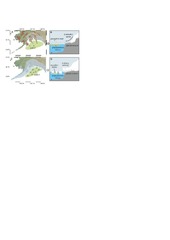Blar i forfatter "Müller, Juliane"
-
Cordilleran ice-sheet growth fueled primary productivity in the Gulf of Alaska, northeast Pacific Ocean
Müller, Juliane; Romero, Oscar; Cowan, Ellen A.; McClymont, Erin L.; Forwick, Matthias; Asahi, Hirofumi; März, Christian; Moy, Christopher M.; Suto, Itsuki; Mix, Alan; Stoner, Joseph (Journal article; Tidsskriftartikkel; Peer reviewed, 2018-02-15)Fertilization of the ocean by eolian dust and icebergs is an effective mechanism to enhance primary productivity. In particular, high-nutrient, low-chlorophyll (HNLC) areas where phytoplankton growth is critically iron-limited, such as the subarctic Pacific Ocean and the Southern Ocean, are proposed to respond to increases in bioavailable Fe supply with enhanced phytoplankton productivity and carbon ... -
The First International Conference on 'Processes and Palaeo-Environmental Changes in the Arctic: From Past to Present' (PalaeoArc)
Lyså, Astrid; Benediktsson, Ívar Örn; Emery, Andy; Gregoire, Lauren; Jennings, Anne; Morigi, Caterina; Müller, Juliane; O'Regan, Matt; Sarala, Pertti; Stokes, Chris; Szczuciński, Witold; Winsborrow, Monica (Journal article; Tidsskriftartikkel; Peer reviewed, 2019-09-13)The new international network PalaeoArc (Processes and Palaeo Environmental Changes in the Arctic: From Past to Present) held its first meeting in Poznan, 20-24 May 2019. The meeting was hosted by the Faculty of Geographical and Geological Sciences, Adam Mickiewicz University, Poznan, and organized by a local committee chaired by Witold Szczuciński. -
Late Quaternary glacier and sea-ice history of northern Wijdefjorden, Svalbard
Allaart, Lis; Müller, Juliane; Schomacker, Anders; Rydningen, Tom Arne; Håkansson, Lena; Kjellman, Sofia Elisabeth; Mollenhauer, Gesine; Forwick, Matthias (Journal article; Tidsskriftartikkel; Peer reviewed, 2020-04-10)The deglaciation history and Holocene environmental evolution of northern Wijdefjorden, Svalbard, are reconstructed using sediment cores and acoustic data (multibeam swath bathymetry and sub‐bottom profiler data). Results reveal that the fjord mouth was deglaciated prior to 14.5±0.3 cal. ka BP and deglaciation occurred stepwise. Biomarker analyses show rapid variations in water temperature and sea ...


 English
English norsk
norsk

